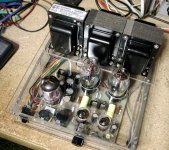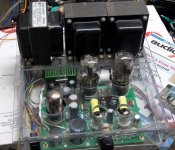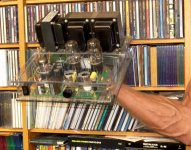Everything was going great until we got to: Connect load to amp, clip volt meters to R18 & R29 and put in the 300B power tubes.
Set the bias at about 68 ma and was getting buzz out of the two small 8 ohm speakers. Then currant reading would drop to 0 and the buzzing stopped after about 1 min. No other noise, it just dropped off to nothing.
B+ was about 370v and then jumped to 440v after the current dropped to 0.
I tried switching from 125v to 110v from the Hammond 276X power transformer but didn't help.
Anyone have any ideas where I should start looking for the problem?
Set the bias at about 68 ma and was getting buzz out of the two small 8 ohm speakers. Then currant reading would drop to 0 and the buzzing stopped after about 1 min. No other noise, it just dropped off to nothing.
B+ was about 370v and then jumped to 440v after the current dropped to 0.
I tried switching from 125v to 110v from the Hammond 276X power transformer but didn't help.
Anyone have any ideas where I should start looking for the problem?
This does sound like filament regulator shutdown from over heat. There should be a heat sink on the chip. The small one listed in the parts list is susally OK for a set of 45 tubes. From your bias current settings you are using 300B's or 2A3's. 300B's need something bigger, and 2A3's need something a lot bigger. How much bigger depends on how much air is moving inside your chassis / cabinet.
The enclosure is wide open at the top for testing. I would think that there would be sufficient air flow to keep regulator cool. I was thinking of running a fan over the board to see if that makes a difference. I do have some larger heat sinks from old computer but I am wondering if that will be enough for when I put the enclosure top back on.
Please, any ideas will be greatly appreciated.
Please, any ideas will be greatly appreciated.
From your bias current settings you are using 300B's or 2A3's. 300B's need something bigger, and 2A3's need something a lot bigger.
Winggo: Are you running 2A3's?? they put the most strain on the regulator...
My Lexan TSE is pretty much worse case. The box is barely large enough to fit the PCB and have room for transformers across the back. It would run OK with 45's, but I needed the heat sink from an old Pentium 1 chip.
Here is the picture of the very first TSE proto running 45's with the stock heat sink. It would shut down after a few minutes with 300B's unless I left the top cover off, and then it would shut down on hot days.
Several years later I swapped out the DIY PC board for a production version and added the green heat sink. It's from a Pentium 1 chip, or maybe even a 486. I also added a choke (hidden under the transformers) and the white supplemental cap seen behind the 45's. These sucked up the remaining air space in the cabinet. It will run forever now with 45's or 300B's but never worked right with 2A3's. The power transformer is too small.
Here is the picture of the very first TSE proto running 45's with the stock heat sink. It would shut down after a few minutes with 300B's unless I left the top cover off, and then it would shut down on hot days.
Several years later I swapped out the DIY PC board for a production version and added the green heat sink. It's from a Pentium 1 chip, or maybe even a 486. I also added a choke (hidden under the transformers) and the white supplemental cap seen behind the 45's. These sucked up the remaining air space in the cabinet. It will run forever now with 45's or 300B's but never worked right with 2A3's. The power transformer is too small.
Attachments
My enclosure is similar to yours, George. Just a little wider. It's basically a wood enclosure with aluminum top. The PCB sets on a heavy piece of aluminum an inch wider than the PCB. There is much of the bottom of the enclosure open under the transformers so that should help air flow. I have over sized the holes for the tubes on the top but I wonder if i should add more air vents to that. I do have a nice heat sink I got off an old computer and I will mount that like you have yours.
I finally got the heat sink mounted, but with the board already wired it was a hell of a job. I busted one end of a tiny, microscopic resistor off and now I have to go in there, like a surgeon, and try and re-solder it. My hands are much more like a blacksmith's than a surgeon's.
Two things I think you should consider including in your instruction, George: First if you are using 300B or 2A3 tubes go ahead and mount a heat sink when you build the board. Two, make sure the builder orders normal size, big resistors rather than those micro ones. Much easier to install and not so fragile when your doing the set up.
Two things I think you should consider including in your instruction, George: First if you are using 300B or 2A3 tubes go ahead and mount a heat sink when you build the board. Two, make sure the builder orders normal size, big resistors rather than those micro ones. Much easier to install and not so fragile when your doing the set up.
My 300B TSE has a similar sized heat sink on the regulator as George is showing with the green heat sink.....mine is mounted on the bottom of the board...hasn't been an issue.
Keep in mind that you can temporarily mount a big heat sink to help diagnose the problem...if the amp still acts up with a monster heat sink mounted the problem is likely somewhere else...just process of elimination. If it solves the problem, stuff the largest one in there that'll fit.
Keep in mind that you can temporarily mount a big heat sink to help diagnose the problem...if the amp still acts up with a monster heat sink mounted the problem is likely somewhere else...just process of elimination. If it solves the problem, stuff the largest one in there that'll fit.
My amp is ready to test but I do not have any 8 ohm speakers here at my shop. Can I test run the amp using 6 ohm speakers? I do have a pair of those. Right now I have it hooked up to a pair of 8 ohm tweeters that I found. I am getting music out of them but it doesn't tell me much about the quality of the sound.
6 ohm, no problem.
I have found that running a tube amp anywhere from half to twice its rated load impedance will do no harm, with the possible exception of an amp that is run into hard clipping a lot, like a heavily overdriven guitar amp.
I routinely try my amps on every available secondary tap if they exist and pick what sounds the best to me. Most speakers are all over the place impedance wise.
I have found that running a tube amp anywhere from half to twice its rated load impedance will do no harm, with the possible exception of an amp that is run into hard clipping a lot, like a heavily overdriven guitar amp.
I routinely try my amps on every available secondary tap if they exist and pick what sounds the best to me. Most speakers are all over the place impedance wise.
Amp is up and running. Sounds great but can't get much volume out of 94db speakers here at the shop. I do have a little hum equal in both speakers. Very low, you have to put ear right up to speaker to hear it. I don't know if it environmental, being produced by something in the shop or if it's in the amp. What do you recommend looking at in the amp for the cause of the hum?
make sure the builder orders normal size, big resistors rather than those micro ones. Much easier to install and not so fragile when your doing the set up.
I have used mainly 1W Vishay and TE Connectivity resistors where the parts list specifies 1/4W resistors - much easier to handle.
Amp is up and running. Sounds great but can't get much volume out of 94db speakers here at the shop. I do have a little hum equal in both speakers. Very low, you have to put ear right up to speaker to hear it. I don't know if it environmental, being produced by something in the shop or if it's in the amp. What do you recommend looking at in the amp for the cause of the hum?
Are you driving the amp with a preamp? I'm running 95db speakers and a preamp and I've got ample volume even for a vaulted ceiling living room....George has mentioned that gain may be slightly less than desired if your source output is low.
For the hum, do you have all the grounds terminating at one place? ("star ground") do you have a separate chassis ground and signal ground point? Twisted the heater wires from the transformer and dressed them away from signal wires?? Chasing noise can be tricky...My Edcor power transformer hums a little....I should attempt to tighten lamination/cover screws.
I am using a passive switch box with volume control. That may end up being a problem, but will set up everything at home on my 97db Sonus speakers and see how that works out.
I built a wood enclosure with 4 aluminum chassis parts and the PCB so I have ground wires running to all those. Most are connected to "star" near the AC connector but some run from one metal piece to the next.
I built a wood enclosure with 4 aluminum chassis parts and the PCB so I have ground wires running to all those. Most are connected to "star" near the AC connector but some run from one metal piece to the next.
Winggo, I've been working on a 300B TSE for the last year, and finally got it running last night. I had the same issue as you already mentioned - not much volume. I was feeding the amp with an MP3 player only (no pre-amp). I ended up using a pro-audio digital crossover to boost the input signal, and now I have real volume. My speakers are 99db efficient. I'm really curious to hear what the experts here have to say about this.
Congrats on getting your amp working!
Dave
Congrats on getting your amp working!
Dave
Where did you get the pro-audio crossover?
I still have a hum problem that I haven't been able to solve yet. A You Tube video says that a hum that does not change volume with the increase on the volume knob is usually a tub problem. I switched out the rectifier tub but no change. I just got in a new pair of 5842 tubs to try. Will do that later today.
I still have a hum problem that I haven't been able to solve yet. A You Tube video says that a hum that does not change volume with the increase on the volume knob is usually a tub problem. I switched out the rectifier tub but no change. I just got in a new pair of 5842 tubs to try. Will do that later today.
- Status
- This old topic is closed. If you want to reopen this topic, contact a moderator using the "Report Post" button.
- Home
- More Vendors...
- Tubelab
- shut down during check out of Tubelab SE


